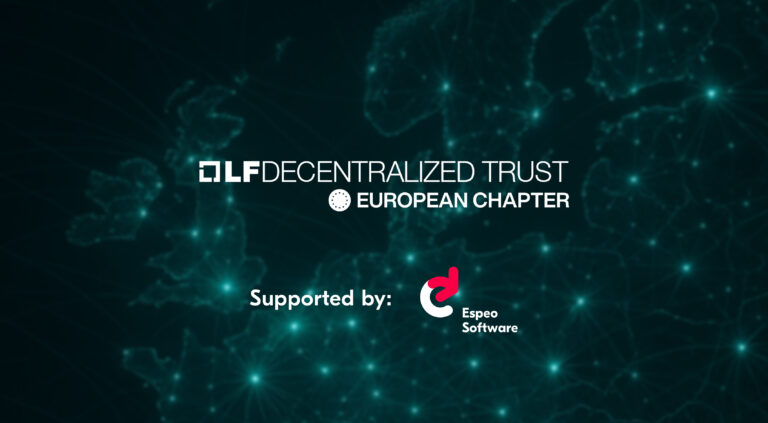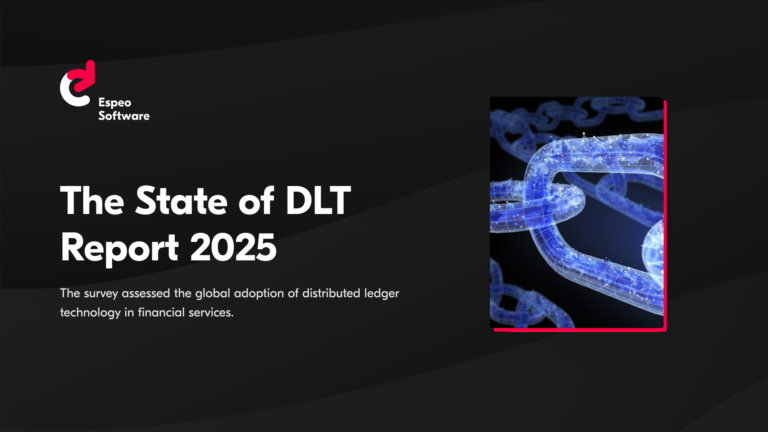Spend any amount of time in the blockchain sector and you’ll find a flood of opinions for ways blockchain technology will be “a game-changer.” Where this goes wrong is that it’s light on how it will change the game exactly and why there’s a game at all. But with the right use cases, organizations can benefit from the efficiency and shared recordkeeping a distributed ledger or specifically Hyperledger Fabric can offer.
A private blockchain for business creates a common version of the truth, the so-called source of truth, that’s difficult to change and easy to audit. Using permissioned networks also limits network participants to ensure data is secure. For businesses, this means better collaboration, streamlining business processes, and more transparency among business partners.
Innovation cycle
Like any technology, it takes a while for the value to finally emerge. Take photography for example. Since the beginning, the point has always been the same. It captures a copy of the truth — however selective — and keeps it forever.
Just like blockchain, early photography was not user-friendly, not cheap, not fast, and not for the masses. The full potential of the technology cannot be released in real-time, but over years as it needs time. Think of early blockchain projects as photography circa 1860 technically limited, reserved for specialists, and complicated to use.
At the time, few grasped its full potential. Many critics objected because an existing medium — painting — captured moments just fine.
Photography’s business benefits are clear to us today in hindsight, though. The global medical imaging market — a spinoff of photography — was worth $25 billion in 2019 according to Markets and Markets report. If Instagram were a stand-alone company Bloomberg estimates it would be worth more than $100 billion.
Of course, the fundamental reason we still take pictures has not changed in nearly 200 years. What has changed is the tools, business opportunities, specific use cases, and major advances in usability. We’re still innovating with blockchain. That’s not to say that there are no benefits, rather breakthroughs unfold as companies invest in development.
Below you can find eight no-nonsense use cases for private blockchains.
Financial settlement
Among the first blockchain including Hyperledger use cases were those in the payments. Cryptocurrencies like Bitcoin, and Ethereum lend themselves well to cross-border and digital payment systems. The world’s most popular public blockchain, Bitcoin, has especially captured a competitive advantage for a niche market. Bitcoin, however, is more of a philosophical choice than practical financial technology. Other blockchain protocols offer better usability and scalability, especially at scale.
At Espeo Software we design enterprise blockchain applications i.e. we have designed a remittance service using the Stellar protocol as an example of a system that will allow the following financial transactions – transfer money quickly and cheaply across borders. Cryptocurrency enables real-time money transfers anywhere in the world. With cryptographic guarantees, blockchain technology facilitates peer-to-peer payments by making sure users can’t spend their tokens twice — double-spending is something other payment processors use financial institutions like banks and credit rating agencies to prevent.
This, of course, removes money transfer services from the transaction, significantly reducing operating costs to transfer money internationally. When end users can trust both contract counterparties it is good for the money and enables more trustworthy peer-to-peer asset transfers.
For internal settlements, though, i.e. Hyperledger Fabric offers a way to both manage and carry out payments between an organization’s branches or close partners. An open and transparent blockchain solution helps organizations to ensure trust and create a transparent record. Network participants can clearly see where transactions go and for what.
Enterprise blockchain for contract validation
Companies with many branches and partners can create an ecosystem with a private blockchain such as Hyperledger Fabric. When a contract expires, certain actions such as issuing an invoice or renewing the contract need to be taken. Currently, these actions are often carried out through manual or semi-automated processes. Companies have to integrate multiple systems and fight data siloing. Using the blockchain network you get one place to store all information consistently and transparently. Moreover, we can use blockchain smart contracts to trigger new automatic actions when the contracts expire. The smart contract’s behaviour can adjust to the asset type and treat different product or service delivery than inventory sales.
Contract validation features can combine with other features like invoices and internal payments. One of the biggest challenges with large companies is transparency and trust between parties. A private, permissioned blockchain together with traditional IT solutions can resolve these problems. While designing software for multiple entities, a consensus mechanism needs to be taken into consideration, as commonly used PoW will generate significant costs.
Invoice processing
Large organizations with global offices struggle with the complexity of invoice processing. Some branches within an organization still do it manually, which can get too complicated. Centralized record-keeping software also limits transparency and can cause chaos when organizations don’t share access to it.
Blockchain enterprise systems using i.e. Hyperledger fabric technology puts all the records a conglomerate produces in one place. Thanks to such a blockchain network none of the organizations can modify the records or add new records without the other participants seeing the change.
Blockchain as a tamper-proof audit trail
What blockchains do is clear — they record a tamper-proof audit trail and distribute a current copy to everyone who’s interested in seeing it. Whether that’s in a public blockchain like Ethereum or in a closed group like the Linux Foundation’s Hyperledger Fabric, the motivation is largely the same. Gather and keep reliable information for every asset type.
What isn’t as clear yet is why.
Die-hard proponents harp on how blockchain will fix the world’s problems. This is overly optimistic, of course. The one reason to use a blockchain is to establish an audit trail, especially if you can’t trust the other actors you’re working with. If you share data with people you trust or don’t share much data at all, don’t think about consensus mechanisms and smart b2b contracts, use a database. This has been our line from the beginning.
Whether you’re tracking invoices, managing referrals, checking a contract’s validity, settling internal payments, managing access to records or tracking supply, tamper-proof auditing matters, and can significantly reduce liability and overhead.
We’ve worked on several of these use-case puzzles in in-house proofs of concept enterprise-grade applications and in applications for our clients. To explore exactly how business blockchain technology and the Hyperledger Fabric network will grow existing businesses and spin off new industries, it’s often important to try to build out a proof of concept first.
Here’s an overview of some of our POC projects and some ways to apply blockchain platforms to business.
Managing data access
One of the many blockchains for business use cases is keeping track of records and who has access to them. In a proof-of-concept application, we’ve developed, our team created an app that manages medical record storage for patients and their doctors based on Hyperledger Fabric.
Patients use their private keys to access a patient portal and can grant and revoke access to doctors. In turn, doctors use their keys to enter a doctor’s portal where they can add records of procedures.
The system shows how the blockchain platform plays a role in securing patient data and can improve some inefficiencies in the current system especially, in the cost of securing medical data. The system’s built-in security allows patients, doctors, and administrators to seamlessly coordinate over the application.
Tracking supply chain network and origin
Another excellent use for a tamper-proof audit trail is in supply chain tracking. Blockchain for the supply chain is one of the areas where we believe in a big technological impact, naming the pharmaceutical supply chain as the starting point. In our supply chain POC, we explored the role of a blockchain-based platform in verifying digital interactions that allow checking if a product has been shipped from a valid source and that it travelled through the supply chain in the right conditions.
Counterfeiting and mishandled drugs account for billions of dollars of losses to Big Pharma each year. Ensuring that consumers get exactly what they’re paying for and verifying that it’s not harmful is the main benefit to this use case.
Additional use cases of blockchain for the supply chain sector are in food tracking. As with pharmaceuticals, a blockchain-based supply platform which is tracking food to its source can help regulators verify that fish, for example, was properly harvested and is the species the package claims. It can also help retailers contain outbreaks of foodborne illness by quickly pinpointing which farm your spinach came from and how it was transported.
Walmart together with IBM has already launched a Hyperledger-based application, FoodTrack, to audit the source of leafy greens in its stores accurately.
Blockchain logistics offer significant utility in handling complex supply chains efficiently.

Commission management
Just as Hyperledger permissioned blockchain projects can help with the efficient processing of invoices, they can also track commissions and clearly show a history of accepted work and the payments for it. This is especially useful for conglomerates that operate in multiple countries that struggle with managing commission or referral payments.
Whether a particular partner uses a different accounting system, provides low-quality data with many duplicates, or is purposefully misrepresenting commissions, an application using Hyperledger Fabric can help establish order.
Blockchain-based time-sensitive distribution
The pandemic has affected all organizations in various possible ways. But it has obviously impacted healthcare organizations most significantly. While science came with its own answers to the situation which began in 2019 – new challenges regarding that occurred as well.
Scientists created effective vaccines, but they have to be transported in very strict conditions and to the places where they will be used on time. Especially at the early stages of vaccination, each dose was close to being priceless and none of it could have been wasted. On the other hand, the rapid introduction of the product to the market and extremely high demand have also encouraged potential frauds and counterfeits.
All of those new issues were solved with blockchain implementation. Tech Mahindra has created an interesting system based on Hyperledger Fabric – VaccineLedger which was developed in cooperation with a startup funded by Unicef and Gavi. Thanks to it the monitoring and distribution of vaccines can operate smoothly using precise information on the logistics, temperature, current location, purchase orders and transport conditions. You can read more about it in Forbes.
Development of an internally secured marketplace
The pandemic has also extorted robust cooperation between healthcare equipment owners. Different entities required special inventory like respirators or oxygen supplies and coordinating these needs with minimal mismanagement is not easy. Medical institutions use different systems, but permanent e-mail and phone coordination is neither accurate nor time efficient. If you add some time that will be consumed by the repairs, operating the central procurement system and a need to care about the patients – the real problem arises.
In order to build a comprehensive, nationwide internal system dedicated to the healthcare industry Healthcare Quality Improvement Partnership has organized a dedicated think-tank. Using the report from the debate as a starting point at Espeo Blockchain we have organized a product specification workshop with one of our clients. As an effect, we have built a prototype with a blockchain framework in mind, planned interaction of different groups of users with the system and infrastructure of private blockchain with direct access for all participants with immutable records by design.
Conclusion of use cases for Hyperledger Fabric
I hope your takeaway from this article, is a better understanding of the fundamental feature of blockchain systems — tamper-proof auditing — and how it drives blockchain use cases.
Shared recordkeeping, smart contracts, supply chain management, shared assets, provenance, and payments are particularly salient now with existing blockchain tech to build apps around. The flexibility of blockchain solutions supports many business use cases even sensitive ones. Other use cases will take more time to work out — especially considering usability for a general audience. Don’t let it discourage you, this is a normal and healthy part of any technological innovation.
As more businesses find valuable Hyperledger Fabric use cases, new ways to innovate will continue to emerge. Blockchain is here to stay, it is important to get education and training on the subject to make an honest assessment of what it is and what it isn’t vital to use it right. And we are here to provide you with every practical guidance you might need.
Do you consider any of the above use cases relevant to your business?
We are helping businesses with powerful enterprise blockchain applications based on Hyperledger fabric. Click here to contact us and one of our experts will get in touch with you.





